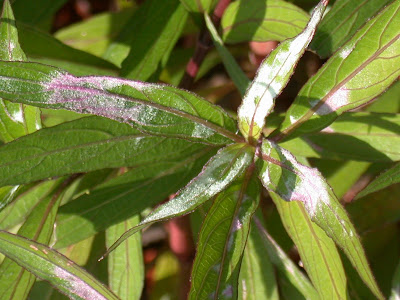
Thursday, October 7, 2010
Tuesday, October 20, 2009
White stuff on Mexican petunia--
 Is anyone treating this "ailment" on Mexican petunia (Ruellia spp.)?
Is anyone treating this "ailment" on Mexican petunia (Ruellia spp.)?OR is it a NBD--no big deal?? Searching for feedback. Answer may be revealed in a few days in an effort to get more input into this BLOG...........
OK, This is NOT a disease! Another landscape phenomenon has created a little controversy as it occurs on Mexican petunia (Ruellia species). Plants are developing white woolly patches on their leaves and stems and people are wondering if it was powdery mildew or a chemical residue. Turns out it is neither.

It is a type of growth distortion called an erineum and it is caused by tiny mites called eriophyid mites (Acalitus ruelliae). The white, tear-drop shaped organism in the center of the picture (3rd image) is one of the mites. This microscope picture shows the distorted growth (resembles fungal mycelium in appearance!) of the Ruellia leaf. 
I doubt treatment is ever needed although there is some leaf distortion. After all, this is a plant which seemingly prospers after an application of Roundup herbicide! But perhaps this information on this bad-mouthed plant may save some people from wasting their money and time on a misdiagnosed fungicide application.
Some landscapers were wondering why worry about this aggressive plant that shouldn’t be used. I reminded them that there is the seedless variety, “Purple Showers” and not to get bent out of shape about seeing it in the landscape. Then they reminded me that it is aggressive just by its flopping vegetative growth habit and runners which cause small plants to grow into large stands of lovely blue flowering shrubbery. My one and only viewing of a malachite butterfly was when it was hovering around my Mexican petunias, a reported host plant!
WHAT TO DO: A horticultural, paraffinic, mineral oil (say, 2% concentration) should do the mites in. Repeat every 5 to 7 days for a total of 3 applications.

I doubt treatment is ever needed although there is some leaf distortion. After all, this is a plant which seemingly prospers after an application of Roundup herbicide! But perhaps this information on this bad-mouthed plant may save some people from wasting their money and time on a misdiagnosed fungicide application.
Some landscapers were wondering why worry about this aggressive plant that shouldn’t be used. I reminded them that there is the seedless variety, “Purple Showers” and not to get bent out of shape about seeing it in the landscape. Then they reminded me that it is aggressive just by its flopping vegetative growth habit and runners which cause small plants to grow into large stands of lovely blue flowering shrubbery. My one and only viewing of a malachite butterfly was when it was hovering around my Mexican petunias, a reported host plant!
WHAT TO DO: A horticultural, paraffinic, mineral oil (say, 2% concentration) should do the mites in. Repeat every 5 to 7 days for a total of 3 applications.
Tuesday, October 6, 2009
Viburnum mystery death
Any ideas what caused five Viburnum suspensum to die?
Here's the symptoms close-up and from a distance. Plants are in hedge with just one affected area, other plants are fine.
- Monocots (cabbage palm seedlings and grasses) were not affected. Brazilian pepper seedlings were fried also.
- The cambium is dead on these 5 plants, so they aren't going to come back easily.
- These are on a slope & mulch is less than 2 inches.
- No indication of heavy fertilizer applications.
- No obvious oily residue on mulch or ground.
- The row of Japanese ligustrum in the same bed, but on the backside had some minor symptoms, no big deal.
- Oak tree isn't affected.
All ideas appreciated. I'm guessing we will never find out, but can't resist the diagnostic quest!
Monday, September 21, 2009
FIcus Whitefly is on the move in Naples

Mid-Sept. 2009: Ficus leaves are dropping in many communities. Confirmed ficus whitefly locations include: Sandpiper and Osprey; Tin City; Market & Commercial Blvd.; Mooring Line and 41 area; Sorrenta Villa (at Goodlette-Frank Road and Pompei Lane); Vanderbilt Beach Rd & I-75; 3rd Ave. NW; Whippoorwill Ln.; Whitaker –off County Barn Rd; 5000 block of Logan Blvd.; Yarberry Lane; and the north end of Nursery Lane.
More biology info at: http://www.doacs.state.fl.us/pi/enpp/ento/Singhiella%20simplex.html and our web site http://collier.ifas.ufl.edu/ has fact sheets on hedge species to consider if you want an alternative to ficus.
WHAT TO DO: See: : http://miami-dade.ifas.ufl.edu/Pests_HT.shtml more on pesticide options later
 We need to be exacting in our dose calculations and chemical selection when applying soil-root drenches especially when we are dealing with miles of ficus hedges such as this one....plus this is a double whammy of tall and short hedge rows.
We need to be exacting in our dose calculations and chemical selection when applying soil-root drenches especially when we are dealing with miles of ficus hedges such as this one....plus this is a double whammy of tall and short hedge rows.
Friday, July 10, 2009
Identifying ficus whitefly vs common planthopper

Ficus whitefly (Singhiella simplex) ID Naples, Florida: I have had several people drive all the way out to our Extension office with an insect they thought was the ficus whitefly. It has turned out to be a planthopper. There are several planthoppers you may find on ficus. They cause little damage, a NBD, no big deal bug. They can easily be separated (now that you can see them side by side) by their size, the whitefly is a little over 1 mm long from head to wing tip. The planthopper is about 6 x larger. Plus the ficus whiteflies have
 their wings flat over their backs (this one was frozen & was thawing so its wings are a little disheveled); whereas the planthopper wings meet over the top like a roof peak.
their wings flat over their backs (this one was frozen & was thawing so its wings are a little disheveled); whereas the planthopper wings meet over the top like a roof peak.The ficus whitefly has a yellow body and two smokey gray bars on each front wing. The first pair of bars is near where the wing is attached and run parallel to its body, but the second pair, about midway on the are aboiut 2X larger and are at right angles to the body. There is another whitefly on ficus (Tetraleurodes fici) but it is larger (on penny) than the ficus whitefly and doesn't have the wing makings as described nor does it have a yellow body. It doesn't tend to build up in large numbers nor cause damage, a NBD kind of whitefly.
Tuesday, July 7, 2009
What to do with sooty mold on coconut trunk???
I have a call from a consultant dealing with a man who owns an island in the Lesser Antilles. Due to a whitefly or/and aphid pests (pests are being dealt with) his coconut palms have sooty mold. This is unacceptable and they have tried to power-wash it off with "soap"- brand? to no avail. So they've started sanding the sooty mold off in the meanwhile!
I suggested a weak chlorine solution (10% bleach to 90% water).
Other ideas:
1. try a horticultural mineral oil (2%) without high pressure and wait a day and then powerwash lightly with water. May take several attempts.
2. The oceanside of the trunks are clean; try using ocean water with low, not blasting pressure. May take several repeated applications.
Has anyone found a one-shot application technique that won't harm the palms?
But really.....
This is strictly a case of the "perfect apple" syndrome and probably few would notice the dark shadow on the trunk. Hopefully they won't be cut down in an attempt to make the view "perfect"??
I suggested a weak chlorine solution (10% bleach to 90% water).
Other ideas:
1. try a horticultural mineral oil (2%) without high pressure and wait a day and then powerwash lightly with water. May take several attempts.
2. The oceanside of the trunks are clean; try using ocean water with low, not blasting pressure. May take several repeated applications.
Has anyone found a one-shot application technique that won't harm the palms?
But really.....
This is strictly a case of the "perfect apple" syndrome and probably few would notice the dark shadow on the trunk. Hopefully they won't be cut down in an attempt to make the view "perfect"??
Subscribe to:
Posts (Atom)



